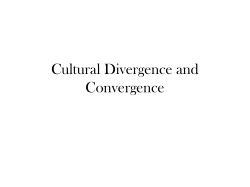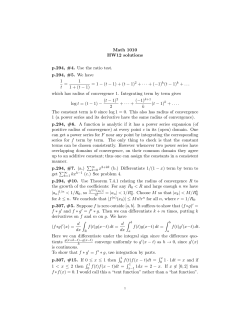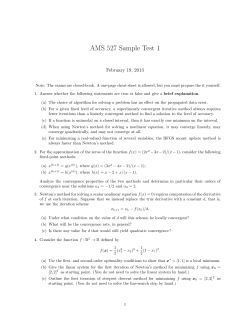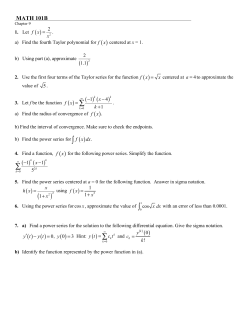
South Africa: Perspectives on Divergence and Convergence Haroon Bhorat
South Africa: Perspectives on Divergence and Convergence Haroon Bhorat1 Professor, Development Policy Research Unit, School of Economics, University of Cape Town Alan Hirsch Professor and Director, Graduate School of Development Policy and Practice, University of Cape Town Introduction A s South Africa entered an unfettered democratic era twenty years ago, the optimistic among us expected that the economic stagnation of the last two decades of apartheid would gradually be left behind. As one of the strongest and most diversified economies in Africa, and certainly the largest, we believed that sensible policies would gradually throw off the shackles of apartheid. It’s location on the African continent which at last, half a century after the end of colonialism was asserting its own right to grow, seemed also to bode well for South Africa. Moreover, the world was changing in a decisive way. Korea and China showed that poor developing countries could take charge of their own destinies and move steadily and swiftly towards convergence with the wealthy countries of the world. But, as we look around the world today, it seems that South Africa was not ready to make that leap to convergence, and that it will take a great effort from imaginative and committed leaders to drive the South African economy towards a path of convergence with the industrialized world. Long-Run Growth Dynamics in South Africa Amongst others, Derviş has pointed to a new “age of convergence in the global economy around 1990 when average per capita incomes in emerging markets began to grow much faster than in advanced economies.” In the two decades after 1990, quite contrary to previous periods, per capita income in emerging and developing economies as a whole grew three times as fast as in advanced economies. For Derviş this marked a delinking in the trend growth rate of emerging economies in the 1990s and developing countries in the subsequent decade. Three factors supported this: globalization, through trade and investment; the demographic transition with the proportion of working age people in developing countries reaching a peak in relation to the population as a whole, and the higher rates of investment in many developing countries.2 What we can see in Figures 1, 2 and 3 is that South Africa does not conform to the general growth pattern of emerging economies, though its performance did not, until recently, diverge a great deal from most of its non-Asian peers. With regard to the overall rate of GDP growth, the rate of per capita GDP growth and the average level of income per capita, South Africa has underperformed most of its peers. Part of the reason for this is well known. At the point of transition to freedom in 1994, the legacy of apartheid was one of the most extremely unequal societies in the world in income, wealth and social and physical infrastructure investment and human capital accumulation. This legacy weighed heavily. However, early in the second decade of freedom it seemed as if some of the backlogs were being rolled back and the growth rate picked up to levels comparable with some of its emerging market peers. After the onset of the global financial crisis, which hit South Africa quite severely, the growth rate fell back to below the rate of most of its peers. THINK TANK 20: Growth, Convergence and Income Distribution: The Road from the Brisbane G-20 Summit 161 figure 1. gdp index in emerging market sample, 1990-2013 GDP Index 10,000 9,000 Brazil 8,000 China 7,000 India Indonesia 6,000 Malaysia 5,000 Philippines 4,000 South Africa Turkey 3,000 2,000 1,000 2013 2012 2011 2010 2009 2008 2007 2006 2005 2004 2003 2002 2001 2000 1999 1998 1997 1996 1995 1994 1993 1992 1991 1990 0 Note: GDP Indexed to 100 in 1990 Source: IMF Economic Outlook 2014 figure 2. real gdp per capita in emerging market sample, anualized growth rate (percent), 1990-2013 10 9 8 7 6 5 4 3 2 1 Source: IMF Economic Outlook 2014 162 THINK TANK 20: Growth, Convergence and Income Distribution: The Road from the Brisbane G-20 Summt China India Korea Malaysia Indonesia Turkey Philippines Brazil South Africa 0 figure 3. gdp per capita levels in emerging market sample (current us$ prices) 25,000 Brazil China India Indonesia Korea 20,000 15,000 Malaysia Philippines South Africa Turkey 10,000 5,000 2012 2011 2010 2009 2008 2007 2006 2005 2004 2003 2002 2001 2000 1999 1998 1997 1996 1995 1994 1993 1992 1991 1990 0 Source: IMF Economic Outlook 2014 figure 4. volume of exports in emerging market sample, percent of gdp 30 25 20 15 10 5 0 -5 -10 -15 Malaysia Indonesia Turkey South Africa 1990 Brazil Korea 2000 2010 Philippines India China Source: IMF Economic Outlook 2014 In retrospect, the boom of the 2004-2008 period was based on a credit bubble, supplemented and underwritten by rising prices for export commodities. But real underlying growth was weak. The poor performance of exports in a period when other emerging markets were expanding real output was symptomatic of an overall low level of investment. Though foreign investment poured into South Africa, it was largely portfolio capital aimed at capturing strong returns in a high margin economy. Little of it was direct investment and little of it was converted into investment that increased the output of the productive sector. THINK TANK 20: Growth, Convergence and Income Distribution: The Road from the Brisbane G-20 Summit 163 Figure 5 shows the very low level of investment in relation to GDP. Though efforts to encourage it improved the rate of investment over the period concerned, the rate remained well below South Africa’s peers, and well below the 27 percent average investment rate of emerging and developing economies calculated by Derviş (2012). Indeed, the average investment rate remained below the rate of 20.5 percent, the relatively low rate of investment of the advanced economies according to Derviş. So, for many of the factors which Derviş identified as characterising the opportunity for convergence in the post-1990 period, South Africa performed considerably below its peers: we have noted that in globalisation (trade and direct investment) and in the level of investment to GDP, South Africa failed to conform to the pattern set by its developing country peers. The third factor identified by Derviş is the demographic transition. In the next section we will focus on why South Africa has been unable to take advantage of the demographic transition, so far. Demographic Transition, Education and Inclusive Growth Sub-Saharan Africa’s share in the world’s population is expected to increase from 12 percent in 2010 to 16 percent in 2030. This demographic transition will have important implications for the size of sub-Saharan Africa’s working age population and therefore, the labor market. More specifically, the region projected to have the fastest growing working age population in the world is sub-Saharan Africa. Yet this demographic dividend is not homogenous across Africa. Whilst economies such as Ethiopia, Kenya and Nigeria yield rapid increases in the working age population, South Africa lags considerably. Estimates show that over the period 2020-2050, South Africa’s working age population will grow at a rate of 0.6 percent per annum, compared with Nigeria, for example, at about 3 percent per annum. Ultimately, in the conception alluded to above, there is no demographic transition projected for the South African economy. South Africa then will not realise the growth gains which can potentially be unleased in much of sub-Saharan Africa through the demographic channel in the form of potential untapped consumer market and a growth potential driven by the rising numbers of young people entering the labor market. If anything, the current inordinately high unemployment levels in South Africa—currently costituting more than a quarter of the economy’s labor force—means that a lower demographic growth rate, is not a liability for medium-run economic growth and welfare prospects for an economy starved of jobs. figure 5. investment levels in emerging market sample, percent of gdp 60 50 40 30 20 10 0 China India Indonesia Korea 1990 Malaysia 2000 Philippines Brazil 2010 Source: IMF Economic Outlook 2014 164 THINK TANK 20: Growth, Convergence and Income Distribution: The Road from the Brisbane G-20 Summt Turkey South Africa One of the possible mechanisms for convergence though, as shown by some Asian economies, remains through improved human capital accumulation across the educational pipeline. In the view of long-run economic growth, currently espoused by Thomas Piketty and others, human capital accumulation is one possible mechanism through which to overcome a growth path where the rate of return on capital (r) exceeds the rate of economic growth (g) – r>g. To generate a more equal growth path, thus equalizing r and g, it is argued that the schooling and educational pipeline plays a potentially crucial role in an economy’s long-run growth trajectory. So, where does South Africa find itself in this area? We noted above the very low growth levels experienced by South Africa, when compared with comparator economies, with much of this driven by low levels of GDFI (gross domestic fixed investment) and domestic savings. South Africa’s educational outcomes, however, do not suggest that the economy currently possesses this lever—arguably so essential for generating a more equal long-run growth trajectory. The South African schooling, vocational training and higher education system does not currently provide the ingredients for the pursuit of longer-run higher and more equal growth outcomes. Figure F estimates mean scores by country based on the Trends in International Mathematics and Science Study (TIMSS). The TIMSS is an ongoing cross-country standardized testing instrument, which measures math and physics competence in-country, at various levels of the schooling system. The survey has been ongoing since 1995 and remains one of the most widely used comparisons for educational performance.3 The results for South Africa reinforce the extent to which the figure 6. standardized mean math and science scores in emerging market sample, 2011 4 3 2 World Average Turkey Tunisia Thailand Slovenia Science South Africa Math Morocco Malaysia Korea Indonesia Hungary Ghana Chile 0 Botswana 1 Notes: 1. 1 indicates below 400; 2 indicates at or above 400 but below 475; 3 indicates at or above 475 but below 550; 4 indicates at or above 550 but below 625; and 5 indicates at or above 625. 2. 400 indicates low international benchmark; 475 indicates an intermediate international benchmark; 550 indicates a high international benchmark; and 625 indicates an advanced international benchmark. 3. Mathematics and Science scores are for Grade 8 as only Grade 8 data was available for South Africa Source: TIMMS (2011) THINK TANK 20: Growth, Convergence and Income Distribution: The Road from the Brisbane G-20 Summit 165 country—in a sample of emerging market peers— lags considerably in schooling performance. The mean scores for math and science for South Africa, stand at 1.7 and 1.8 respectively. Putting this into perspective, the global average for the two subjects was between 26 and 28 percentage points higher than that of South Africa. Hungary, Slovenia and Korea readily score twice as well, whilst Turkey, Thailand and Malaysia produce results which are between 35 and 70 percent higher than South Africa. Only Ghana in this sample scores below South Africa. Perhaps a more powerful reflection of the failure of the South African schooling system lies in the production function estimates provided below. The results, in Table 1, are based on a two-stage, semi-parametric production function which controls for both the simultaneity and non-linearity concerns.4 We measure, as is standard in the growth literature, the logged number of employed and those in the population as a whole, by education level. table 1: production function estimates of schooling, 1995-2012 Dependent Variable: Real GDP By Industry Variables Employed Population None -0.024 0.029 Primary -0.023 0.164 Secondary 0.145 0.669*** Matric 0.159 -0.037 Certificate -0.05 -0.025 0.104** 0.095* Degree Standard errors in parentheses: *** p<0.01, ** p<0.05, * p<0.1 1. Dependent variable is annualized quarterly gross domestic product by industry at constant 2005 prices. 2. Control variables are those for capital and investment expenditure. Capital, a stock variable, is measured by the rand value of tangible goods including fixed property, plant and equipment, while investment captures its gross formation. All variables are logged. 3. Capital and investment expenditure include 3rd order polynomials, which serve as additional controls, to proxy for the unobserved productivity shocks and resolve the simultaneity problem of the functional relationship between investment and capital. . 4. A constant term is not included because the model assumes that the effect of TFP is invested within labor by various levels of education as human capital gains. Source: Bhorat, Cassim & Tseng (2014) 166 THINK TANK 20: The results are stark. They suggest that when examining the employed only, the entire schooling pipeline does not significantly contribute to longrun economic growth in the South African economy. It is only the employed, with a qualification from a higher education institution in South Africa, where a significant and positive impact on economic growth is recorded. When the sample is switched to the population as a whole, the secondary schooling system does have some positive impact on economic growth. Ultimately though, the evidence suggests either a weak or non-responsive schooling system in South Africa, with respect to impacting on productivity gains and economic growth. The notion then that income inequality can be mitigated through human capital accumulation is surely not feasible within the current schooling environment in South Africa. Put differently, it is not evident that South Africa is at a point at which the institutions of human capital can act as a mechanism for growth convergence. The above suggests that on the basis of low economic growth, a divergence from the growth trajectory of high-income economies and poor quality outcomes in human capital, that South Africa’s economic growth path would be both uneven and highly unequal. This growth path, without the channels through which to more evenly distribute the gains from growth, would be delivering growth to those with high initial endowments of land, capital and education. Indeed, this is in many ways a summary of the general nature of South Africa’s long-run growth path. In order to explain these distributional outcomes from economic growth, we use a Growth Incidence Curve (GIC) for South Africa over the period, 1995 to 2010. This period covers the first 15 years of democracy in South Africa. The graph suggests very clearly that the gains from economic growth have been unevenly shared across the income distribution. In particular, the data show that since 1995, those households at the top-end of the distribution have seen their real per Growth, Convergence and Income Distribution: The Road from the Brisbane G-20 Summt figure 7. growth incidence curve for south africa, 1995-2010 per capita growth in pcreal_total inc 2 1 0 -1 0 20 40 60 80 100 poorest p% ranked by pcreal_totalinc Growth incidence curve Growth rate in mean Mean of growth rrate Notes: 1. The 1995 population weights are based on the cross-entropy methodology calibrated using ASSA’s 2003 population model. 2. The 2010 population weights are based on the 2001 Population Census. Source: Statistics South Africa (1995 and 2013); Own Calculations using Per Capita Household Income capita income rise by over 2 percent per annum. Mean income increased at a real average annual rate of just less than 1 percent, whilst median incomes declined marginally. Two additional results are important from this GIC: Firstly, those in the middle of the income distribution have witnessed a decline in their real incomes since the end of apartheid. Secondly, for the poor, the state has provided income support in the form of an extensive social protection scheme, built around support for the elderly and children. As a consequence the incomes of the poor since the end of apartheid have either remained steady or increased a little. Ultimately, though, the poor returns from human capital accumulation, driven by the poor quality of the schooling system, have served to reproduce a highly unequal growth path in South Africa. There are limits to a redistributive state especially when growth is pedestrian, and whilst the incidence of growth suggests some support for the poor, in the main there is a strong evidence here of the unequal and uneven nature of this economy’s growth trajectory. Conclusion The above suggests that South Africa’s long-run growth trajectory remains defined by low levels of per capita economic growth, in comparison with its emerging market peers. Low levels of investment and mediocre export growth, coupled with an unhealthy dependence on portfolio inflows, all serve to reinforce an undynamic growth path for Africa’s most advanced economy. With South Africa’s very high unemployment rate, the lack of a demographic bulge may be advantageous to this low growth outlook for the economy. However, a poor social return from human capital THINK TANK 20: Growth, Convergence and Income Distribution: The Road from the Brisbane G-20 Summit 167 accumulation, driven by a low quality schooling system, provides yet another key growth constraint in the post-apartheid period. The result is a highly unequal, slow growth economic development path which, if not effectively addressed, will perpetuate the current path of long-run economic divergence. In the G-20 St Petersburg Action Plan, South Africa committed itself to the following structural reforms: “South Africa will take steps to resolve the energy constraint by starting the process to build a third coal-fired power plant and finalizing the process of authorizing shale gas exploration in a responsible and environmentally friendly manner. South Africa plans to improve the investment environment through streamlining the procedure for obtaining environmental impact assessments for water and mining projects.” These proposed reforms address some important issues—the energy deficit and clumsy regulation— but not much has been achieved, perhaps thankfully, towards shale gas exploration and a new coal-fired power station. In the 2014 Action Plan it would be welcome to see a greater commitment to critical structural impediments to growth. Most important are measures to increase the pace of investment, and the firm commitment of the government to policies that encourage savings and investment rather than growth through government consumption, consumer credit extension and reliance on foreign inflows of portfolio investments. Interventions to lift constraints in the labor market, including encouraging skilled in-migration and to reduce the level of conflict in industrial relations are crucial. Finally, a real commitment to improving the quality of basic and post-school education and training is absolutely critical. 168 THINK TANK 20: References Bhorat.H, A.Cassim & D.Tseng. 2014. “Higher Education, Employment and Economic Growth: Exploring the Interactions.” Development Policy Research Unit, School of Economics, University of Cape Town. March. Derviş, Kemal. 2012. “Convergence, Interdependence and Divergence.” Finance and Development, IMF, September. Olley, S. & Pakes, A. 1996. “The Dynamics of Productivity in the Telecommunications Industry.” Econometrica, 64(6), pp. 1263-1298. Statistics South Africa. 1995. October Household Survey 1995. Part 2- Income and Expenditure of Households. Pretoria: Statistics South Africa. Statistics South Africa. 2012. Income and Expenditure of Households 2010/2011. Metadata. Report No P0100. Pretoria: Statistics South Africa. TIMSS. 2011. Trends in International Mathematics and Science Study. Survey Data. Available at http:// timssandpirls.bc.edu/timss2011/index.html Endnotes 1. The authors gratefully acknowledge the superb research support of Aalia Cassim and Kavisha Pillay. 2. Derviş (2012) 3. More details on the method, testing approach, questionnaire and detailed results can be found at http:// timssandpirls.bc.edu/#. 4. Olley & Pakes (1996) Growth, Convergence and Income Distribution: The Road from the Brisbane G-20 Summt
© Copyright 2025

















